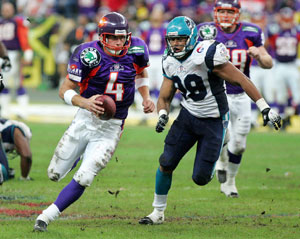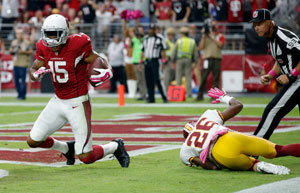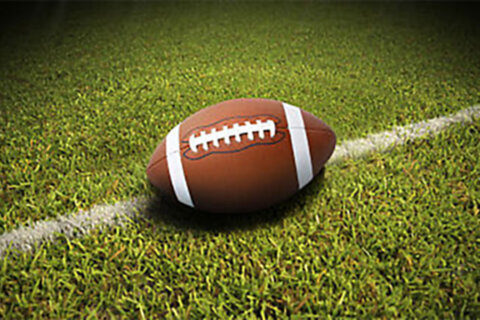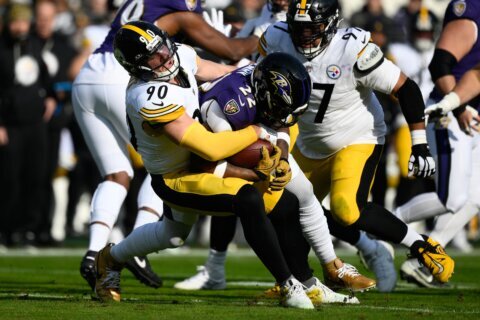WASHINGTON — You’ve heard it all before. Remember “Suck for Luck”? Now there’s #SuckForTheDuck, the hashtag for Titans’ fans desire to finish with the NFL’s worst overall record, so they can take Oregon quarterback Marcus Mariota with the first overall pick in the 2015 NFL Draft.
In American professional sports, non-playoff teams are actually rewarded the worse they are, to provide a measure of competitive balance. To some degree it works, but it also encourages bad teams to tank as hard as possible as they look for the next year’s number-one pick.
But what if American sports — football, in particular — used a relegation system like the one in European soccer, in which the bottom three teams are sent to a lower division each season, replaced by the top teams below them?
Baseball’s minor league system is already too structured with franchise affiliations, as is hockey’s. Basketball — through the D-League — is heading down that path. But football remains without a minor league system or structure. What if the NFL created a sub-league, whether by acquiring teams from existing leagues or starting new franchises which could earn entry into the NFL? What might such a league look like?
Disclaimer: This is an exercise in creativity and madness. Some of this will no doubt seem absurd. However, most of the expansion would not require massive capital improvements and would use existing infrastructure. Perhaps some cities will seem unfeasible. But bear with us and tell us honestly, when we’re through, whether this doesn’t sound like a more entertaining way to enjoy football and keep fans of all teams interested year-round.
Down the rabbit hole we go…
WEST
Las Vegas: Vince McMahon tried a team there for the XFL. It’s a big enough market, and if nothing else, would be entertaining.
Los Angeles (1): We all know LA wants another pro football team. Instead of an NFL franchise…
Los Angeles (2): …let’s just give them two AFL ones. Draw the old Rams/Raiders battle lines and pick a side.
Vancouver: Often forgotten in the North American sports landscape, Vancouver is home to more than 600,000 residents and is a natural neighbor (and potential rival) for Seattle.
CENTRAL
Chicago: The third-biggest city and DMA in the country, Chicago could easily support a second team, and already has the infrastructure to do it.
Louisville: Already a great college football town, Louisville boasts Papa John’s Stadium, capacity 55,000, on the edge of downtown.
Oklahoma City/Norman: OKC has shown its passion as a sports town with the success of the Thunder, and with the University of Oklahoma just down the road, a stadium is already in place.
San Antonio: A football-starved city of more than 1.3 million with the Alamo Dome already at their disposal? This one’s a slam dunk.
EAST
Birmingham/Tuscaloosa: Saturday football dominates in SEC country, but surely there’s room for a pro team to unite Auburn and Alabama fans.
Montreal: Long forgotten about as Toronto’s little brother up north, Montreal’s CFL Alouettes draw better than 20,000 a game.
Raleigh-Durham: One of the fastest-growing areas in America, the Research Triangle now has well over 2 million residents, but only an NHL team among top flight professional sports franchises.
Toronto: After years of flirting with the Bills, Canada’s biggest city could now take its own shot at breaking into the NFL.

EUROPE
Dublin: With a metro population of over 1.8 million, Ireland’s hub provides a natural UK rivalry with…
Edinburgh: Forget the French. The Scottish are huge rugby fans and already have Murrayfield Stadium, which holds over 67,000 spectators.
London: The hub of the NFL’s European efforts, there would be considerable push behind seeing that this squad find a way to get promoted into the big leagues.
Frankfurt: Yes, Frankfurt. With a population over 700,000, the city put up easily the highest attendance numbers in the days of NFL Europe, averaging over 33,000 in the final season of the Frankfurt Galaxy (more than 65 percent higher than league average). Congratulations; you learned something today.
Relegation
The top three teams from the new AFL would gain automatic entry into the NFL. However, this wouldn’t be based on a table like it is in soccer, because that’s not how we do things in America. The winner of each division would make the playoffs, with the semifinal winners gaining automatic entry. The semifinal losers would then play for the third and final spot, with the winners playing for the championship.
Just imagine — your team playing a game for the chance to rise into the NFL. You’re telling me you can’t envision 100,000 people turning out in Tuscaloosa for that?
Moreover, it would mean the NFL’s bottom feeders couldn’t just mope along to another awful season, with season ticket holders feeling like their money had been flushed down the drain. You don’t think the Raiders and Jaguars would pull out all the stops each week to try to find a win? Think about the money at stake. These are actual Week 15, 16 or 17 matchups this season:
Jets at Titans (Week 15)
Titans at Jaguars (Week 16)
Giants at Rams (Week 16)
Bills at Raiders (Week 16)
Jaguars at Texans (Week 17)
We don’t know exactly how the rest of the year will play out, but those will likely be terrible, pointless football games. And they might still be terrible, but they’d have a much bigger sense of urgency to them if teams were playing for their NFL lives. They’d certainly no longer be pointless.

You don’t think the Redskins, sitting at 1-5 with games remaining at Dallas, at San Francisco, at Indianapolis, and at home against the Eagles and Cowboys to finish the year, might be worried? It would make those last games much more than just potential spoilers for their opponents.
The trickiest part would be working out the NFL Draft. My initial thought is to keep it the same, with the three promoted teams moving up and also earning the first three picks in the draft (in the order that they finished the season prior, top down). This rewards them, and gives them a chance to get immediately better as they face tougher competition.
The rest of the draft would play out among the 32 NFL teams, then go to the 16 AFL teams at the end of each round. This would continue to benefit the teams that played well and avoided relegation. It would also expand the number of picks from 224 to 336. We all know that undrafted players pop up and do big things from time to time (Austin Davis, anyone?), so this would give more of those players a chance to do just that. Instead of bouncing around practice squads, players could find themselves with new opportunities to play every week and prove themselves.
Other perks
Preseason games could pit NFL teams against AFL ones to help drive interest in the new markets, especially abroad.
New teams mean new logo sets, new hats, new jerseys, new jackets. All of that means more revenue for the league as it gets off the ground.
Maybe the current owners could get some sort of share of the new league’s merchandise sales to help compensate them and make them more amenable to the idea. After all, more revenue is never a bad thing. Right Mr. Goodell?






